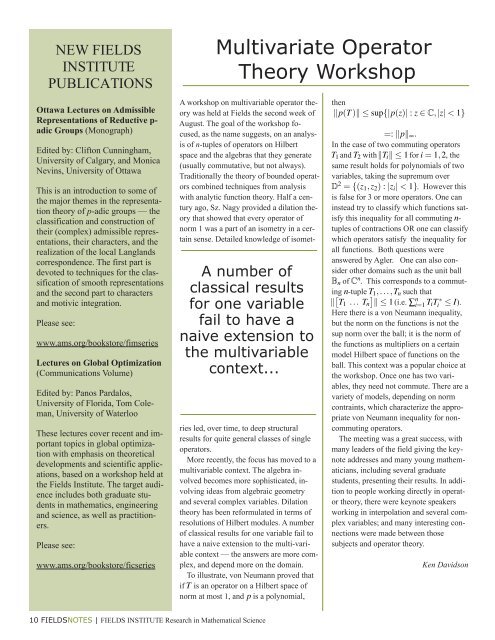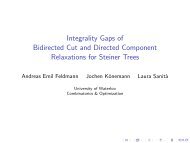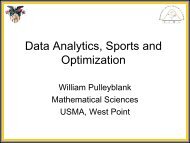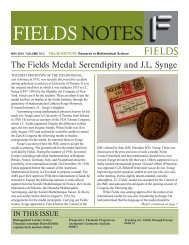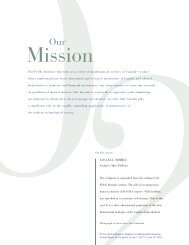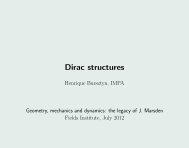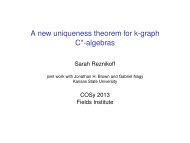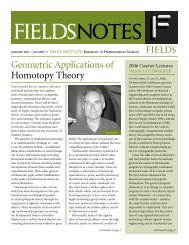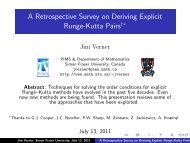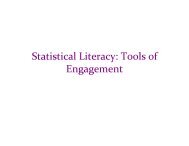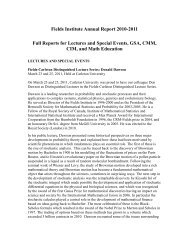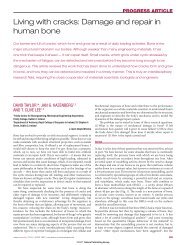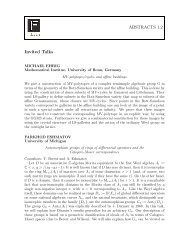Fields Notes, September 2009 - Fields Institute - University of Toronto
Fields Notes, September 2009 - Fields Institute - University of Toronto
Fields Notes, September 2009 - Fields Institute - University of Toronto
Create successful ePaper yourself
Turn your PDF publications into a flip-book with our unique Google optimized e-Paper software.
NEW FIELDS<br />
INSTITUTE<br />
PUBLICATIONS<br />
Ottawa Lectures on Admissible<br />
Representations <strong>of</strong> Reductive padic<br />
Groups (Monograph)<br />
Edited by: Clifton Cunningham,<br />
<strong>University</strong> <strong>of</strong> Calgary, and Monica<br />
Nevins, <strong>University</strong> <strong>of</strong> Ottawa<br />
This is an introduction to some <strong>of</strong><br />
the major themes in the representation<br />
theory <strong>of</strong> padic groups — the<br />
classification and construction <strong>of</strong><br />
their (complex) admissible representations,<br />
their characters, and the<br />
realization <strong>of</strong> the local Langlands<br />
correspondence. The first part is<br />
devoted to techniques for the classification<br />
<strong>of</strong> smooth representations<br />
and the second part to characters<br />
and motivic integration.<br />
Please see:<br />
www.ams.org/bookstore/fimseries<br />
Lectures on Global Optimization<br />
(Communications Volume)<br />
Edited by: Panos Pardalos,<br />
<strong>University</strong> <strong>of</strong> Florida, Tom Coleman,<br />
<strong>University</strong> <strong>of</strong> Waterloo<br />
These lectures cover recent and important<br />
topics in global optimization<br />
with emphasis on theoretical<br />
developments and scientific applications,<br />
based on a workshop held at<br />
the <strong>Fields</strong> <strong>Institute</strong>. The target audience<br />
includes both graduate students<br />
in mathematics, engineering<br />
and science, as well as practitioners.<br />
Please see:<br />
www.ams.org/bookstore/ficseries<br />
A workshop on multivariable operator theory<br />
was held at <strong>Fields</strong> the second week <strong>of</strong><br />
August. The goal <strong>of</strong> the workshop focused,<br />
as the name suggests, on an analysis<br />
<strong>of</strong> ntuples <strong>of</strong> operators on Hilbert<br />
space and the algebras that they generate<br />
(usually commutative, but not always).<br />
Traditionally the theory <strong>of</strong> bounded operators<br />
combined techniques from analysis<br />
with analytic function theory. Half a century<br />
ago, Sz. Nagy provided a dilation theory<br />
that showed that every operator <strong>of</strong><br />
norm 1 was a part <strong>of</strong> an isometry in a certain<br />
sense. Detailed knowledge <strong>of</strong> isomet<br />
ries led, over time, to deep structural<br />
results for quite general classes <strong>of</strong> single<br />
operators.<br />
More recently, the focus has moved to a<br />
multivariable context. The algebra involved<br />
becomes more sophisticated, involving<br />
ideas from algebraic geometry<br />
and several complex variables. Dilation<br />
theory has been reformulated in terms <strong>of</strong><br />
resolutions <strong>of</strong> Hilbert modules. A number<br />
<strong>of</strong> classical results for one variable fail to<br />
have a naive extension to the multivariable<br />
context — the answers are more complex,<br />
and depend more on the domain.<br />
To illustrate, von Neumann proved that<br />
if T is an operator on a Hilbert space <strong>of</strong><br />
norm at most 1, and p is a polynomial,<br />
10 FIELDSNOTES | FIELDS INSTITUTE Research in Mathematical Science<br />
Multivariate Operator<br />
Theory Workshop<br />
A number <strong>of</strong><br />
classical results<br />
for one variable<br />
fail to have a<br />
naive extension to<br />
the multivariable<br />
context...<br />
then<br />
p(T ) ≤ sup{|p(z)| : z ∈ C,|z| < 1}<br />
=: p∞.<br />
In the case <strong>of</strong> two commuting operators<br />
T1 and T2 withTi ≤ 1 for i = 1,2, the<br />
same result holds for polynomials <strong>of</strong> two<br />
variables, taking the supremum over<br />
D2 = {(z1,z2) : |zi| < 1}. However this<br />
is false for 3 or more operators. One can<br />
instead try to classify which functions satisfy<br />
this inequality for all commuting ntuples<br />
<strong>of</strong> contractions OR one can classify<br />
which operators satisfy the inequality for<br />
all functions. Both questions were<br />
answered by Agler. One can also consider<br />
other domains such as the unit ball<br />
Bn <strong>of</strong> Cn . This corresponds to a commuting<br />
ntuple T1,...,Tn such that<br />
<br />
n<br />
T1 ... Tn ≤ 1 (i.e. ∑i=1 TiT ∗<br />
i ≤ I).<br />
Here there is a von Neumann inequality,<br />
but the norm on the functions is not the<br />
sup norm over the ball; it is the norm <strong>of</strong><br />
the functions as multipliers on a certain<br />
model Hilbert space <strong>of</strong> functions on the<br />
ball. This context was a popular choice at<br />
the workshop. Once one has two variables,<br />
they need not commute. There are a<br />
variety <strong>of</strong> models, depending on norm<br />
contraints, which characterize the appropriate<br />
von Neumann inequality for noncommuting<br />
operators.<br />
The meeting was a great success, with<br />
many leaders <strong>of</strong> the field giving the keynote<br />
addresses and many young mathematicians,<br />
including several graduate<br />
students, presenting their results. In addition<br />
to people working directly in operator<br />
theory, there were keynote speakers<br />
working in interpolation and several complex<br />
variables; and many interesting connections<br />
were made between those<br />
subjects and operator theory.<br />
Ken Davidson


